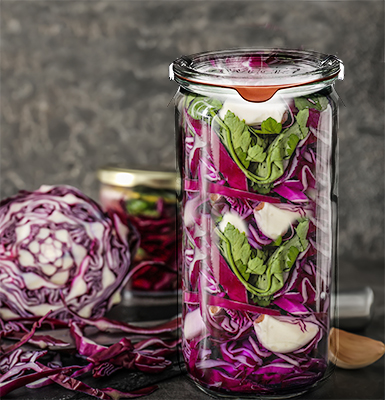
At the moment fermentation and preserving are very popular. Already 6000 BC man used fermentation to conserve vegetables, fruits, meat and fish as fermentation just required water, salt and time – and nature cared about the rest.
When food is left for a longer time microbes tamper with it and food can spoil. Fermentation is controlling this process. Bacteria, fungi and other cell cultures, i.e. "good organisms" split food to its parts, the so-called enzymes. During the fermentation process vegetables, meat or fish change their paste in a positive way and contain more valuable ingredients. Moreover fermented food is more digestible than non-fermented food.
Fermentation is known among all cultures. In this country e.g. sauerkraut, graved salmon, yoghurt, coffee, tea and cocoa are familiar ferments. In Korea people eat kimchi, in Japan they eat miso and soya sauce is also a product of fermentation. Digestible drinks like beer, wine and whisky are obtained through fermentation.
Now that resource preservation and sustainability are popular fermentation stages a comeback as a sustainable method of conservation. Fermentation doesn't require any heating or cooling and thus no electric power. Moreover no additional preservatives are needed and some basic ferments don't even require vinegar or yeast. During the fermentation process food is simply inserted into a brine containing non-iodized salt. The salt concentration is about two to five percent. Then you have to wait three to five weeks. During this period fermentations creates in a natural way e.g. lactic acid keeping wholesome the content.
Jars and accessories can be used several times even through the years for fermentation. Moreover fermentation doesn't cause any packaging waste. On principle it's possible to ferment any vegatables, but best are fresh, seasonal and bigological vegetables of highest quality produced in the same region. A seasonal calender is helpful to avoid long transport routes or expensive cooling.
Fermentation is a method of conservaton that can be applied by everyone. For fermentation you just need a jar with rubber seal or silicone lids, e.g. produced by WECK, Bormioli Rocco, Le Parfait or Einkochwelt.
To avoid the presence of unwelcome bacteria during the fermentation process the jars must be thoroughly cleaned before. It's recommended to boil jars, lids, rubber rings, clamps and accessories in hot water for a couple of minutes. Alternatively there can be sterilized in the oven.
During the fermentation process the content must be covered sufficiently by the brain. Before closing the jars check if the lid sides and rubber seal contain some residues of the filling and clean if necessary. The filled jars can be storaged at a room temperature up to 15°C. Cooling isn't required during the fermentation – it would even inhibit the process.
After the first two to three days the first gas bubbles are formed – this is a good sign that means that fermentation is going on. As the gas causes an overpressure in the jar the container should be ventilated shortly every two to three days or the lid should be placed for a short time. There is a slighlty sour smell due to lactic acid! The amount of gas bubbles decreases after three to four weeks according to the filling, the concentration of the salt brain and the ambient temperature. Check visually shaking the jar slightly. Nevertheless the fermentation process goes on. It can be decelerated puttin the jar into the fridge. Placing the jar in hot water again the fermentation process will be stopped (and the taste of the content will be changed subsequently).
Fermentation extends the possible flavours of food. Vegetables and frutis that were fermented in a salt brain, e.g. salted tangerines have an intensive taste apart from a sour-salty flavour. That's why ferments are often added as spices, toppings, natural flavour enhancer or other components to a dish.
Kimchi - a dish as an integral part of Korean culture
Actually a generic term for fermented vegetables, there are numerous recipe variations today. Here we present the well-known recipe with Chinese cabbage.